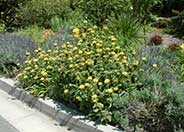Hotlinks:
| Designer: Terry Gardner | Beautiful to Behold |
Photographer: GardenSoft |
Soils and Compost:
Physical weed control, including mulching, or hand removal protects the watershed from harmful chemicals.
Integrated Pest Management:
Remove irrigation water and fertilizer from areas where you don't want weeds to grow.








